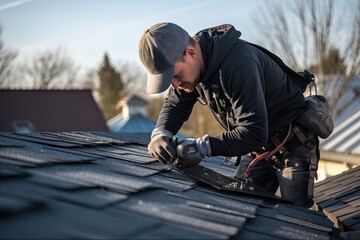Palm Coast Roofing Companies are a businesses that provide services related to roofs. They often use technology to streamline operations, such as project management software and drones for roof inspections.
They also use quality materials that meet your area’s weather conditions. Experienced contractors identify issues and address them appropriately, saving homeowners from costly repairs in the future.
Roofing is complex and hazard-filled work that requires a great deal of specialized knowledge and expertise to complete successfully. Experienced roofing companies have a deep understanding of the nuanced complexities involved in different roofing systems and materials, allowing them to tackle projects quickly and efficiently. They also have the ability to anticipate potential challenges and pitfalls, ensuring that every aspect of your roof repair or replacement is addressed with precision.
The roof is one of the most critical elements of any building, keeping bad weather out and ensuring that the interior stays dry and insulated from above. A faulty roof can cause water leaks, structural damage and loss of energy efficiency. Experienced roofers know how to install and maintain a variety of roofing materials, including flat roofs, pitched roofs and even green or vegetative roofs. They can also identify and fix problems like sagging, water leaks and electrical hazards.
Moreover, experienced roofers have the ability to understand and follow industry safety protocols. This helps minimize the risks of accidents and ensures that all parties involved in the project are kept safe. They also have the knowledge to use a variety of tools and machinery like harnesses, safety nets and ladders safely.
Additionally, roofing contractors have good time management skills and are able to meet deadlines while maintaining high standards of quality. They can plan and schedule tasks appropriately, order and deliver materials on time and keep themselves and their crews hydrated during long work periods on the roof.
Locally-owned, family-operated roofing companies are well-versed in the city and county regulations for construction projects. They are also knowledgeable about the climate and weather patterns of their region, enabling them to time projects according to conditions. Additionally, they can identify and source premium-grade roofing materials that will hold up to the local weather without leaking or deteriorating prematurely.
In addition, they have the technical expertise to examine storm damage thoroughly and diagnose the underlying causes of the problem, identifying issues homeowners may not notice. This allows them to execute thorough repairs that will last for years.
They Save You Money
You can save a great deal of money on your roofing project by choosing to hire a local, family-operated roofing company. These companies often have standing with local vendors, enabling them to purchase materials at lower prices. This, in turn, allows them to pass the savings on to their customers.
Many of these companies also offer warranties on their work and materials, adding another layer of security to the investment you’re making in your home. They may even have relationships with manufacturers that enable them to provide extended warranties, which can further reduce the risk of future issues.
A pro job on your roof can save you a considerable amount in energy costs, too. A well-installed roof will keep the cold air out in winter and the hot air out in summer, keeping your heating and cooling bills low. Moreover, some roofing materials are designed to reflect sunlight, further reducing your energy bills.
Roofing contractors are generally licensed, insured and bonded, which protects you against any unforeseen costs or problems. They can typically provide you with a detailed full-scope of work and estimate, which can be an invaluable tool in evaluating different options for your new roof. They can also provide you with references from previous clients and can answer any questions or concerns that you may have.
Despite all the advice available online, it’s still a fact that more new roofing businesses fail than succeed. One of the biggest pitfalls that many people fall into is overestimating their startup costs, including expenses such as equipment, advertising and promotion. The secret to avoiding this pitfall is to plan carefully from the start and only take on jobs that you can profitably complete. A good accountant is a key component to this process and should be involved from the very beginning. During the startup phase, don’t spend more than necessary on tools or a truck; use a used vehicle that can handle the load and haul your supplies. Also, focus on a single type of job to avoid over-investing in tools and materials.
They Are Reliable
Roofing contractors specialize in roof installation, repair, and maintenance. They often perform other home improvement projects such as siding, window installations, and chimney rebuilding and capping. They also perform skylight and gutter cleaning and screening, and block work repair. Choosing a residential roofing company that specializes in multiple home exterior projects can save you time and money by allowing you to get your entire project done by one professional team.
Choosing a roofing contractor with an excellent reputation is the best way to ensure high-quality work and satisfaction with the job. Ask your friends, family, and neighbors for recommendations, or check online reviews on sites such as Angi’s List and HomeAdvisor. Look for an established company with a professional website and a physical address in your area.
A reliable roofing company will provide transparent pricing and a clear contract. They should also be able to answer any questions you may have and explain any warranties or after-sales service they offer. They should follow strict safety guidelines and take precautions to protect your property during the work process.
When you choose a roofing company, it is important to find out whether they are insured and licensed in your state. A reputable company will be able to provide you with proof of insurance and licensing, as well as a list of customer references. In addition, they should be able to explain any roofing techniques and materials they use.
A roofing company should not use high-pressure sales tactics or pressure you into purchasing a specific product. If a roofing company is pushing a particular type of roof or color of shingle, it could be a sign that they are not as reputable as they claim.
A trusted roofing company will be able to provide you with a written estimate that includes the scope of the project, costs for materials and labor, and any other charges or fees. They should also be able to give you an approximate timeline for completion. If you are not happy with the work, a reliable roofing company will be willing to resolve any issues.
They Are Local
Local roofing companies tend to offer a more personalized experience when compared to national firms. Homeowners often work directly with the company owner or a small team of dedicated professionals who prioritize understanding their clients’ needs and vision for their roof. This approach provides an opportunity for open communication, and ensures that homeowners’ concerns are addressed.
Local roofers are also more familiar with the unique challenges that can occur in their area. This means that they will be able to recommend the best roofing materials for the region, which can help save homeowners money on energy costs. They will also be able to provide recommendations on how to keep the roof in good condition, including regular inspections and maintenance.
Moreover, local contractors are hyperfocused on standing by their work and are more likely to respond quickly to questions from homeowners, both during and after the roofing process. This is in stark contrast to larger national contractors that may lag in response times. Local roofers also understand the regional weather patterns and can recommend roofing solutions that will be more resistant to inclement conditions.
When hiring a local roofing company, homeowners should also make sure that the company is licensed and insured. The licensing requirements will vary from one state or province to the next, but typically include a contractor’s license, general liability insurance and workers’ compensation coverage. Depending on the type of business, a roofing company may also need to obtain a business permit.
Choosing a local roofing company is a great way to support the community and the economy. It will also provide homeowners with the peace of mind of knowing that if something goes wrong, their local roofing company is just a phone call away and can be onsite promptly to resolve the issue.
When selecting a local roofing company, it is important to do your research and read online reviews. You should also choose a roofing company that is willing to work with your budget and schedule. A reputable roofing company should be licensed and insured, and will have a website that offers detailed information about the services they offer.



